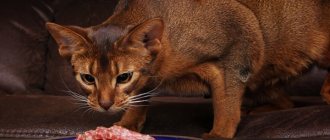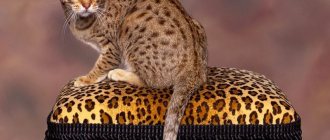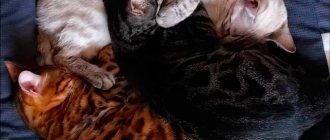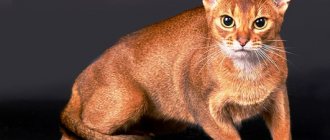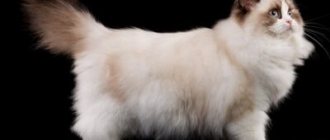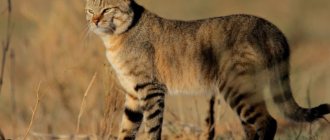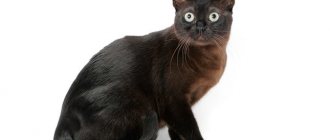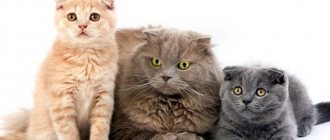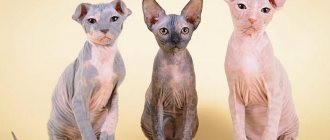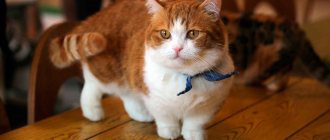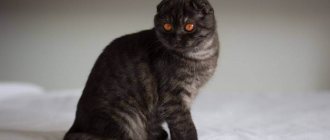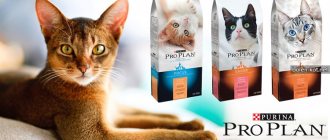The main distinguishing features of the color of the Abyssinian cat are ticking (hair coloring in zones) and the complete absence of patterns on their skin (spots, marbles, stripes). Looking at the fur of an Abyssinian cat, you will see that each hair is painted with alternating light and dark stripes. The undercoat of Abyssinian cats is rich and bright.
Disqualifying faults in Abyssinians are: white medallion on the chest or white anywhere on the coat except the chin; a closed necklace on the chest; cool gray tone of the undercoat throughout the cat’s body; The Sorrel color has any black hairs and unrecognized colors.
Abyssinian cat fur ticking
There are currently four officially recognized colors of Abyssinian cats: sorrel, wild, fawn and blue.
Abyssinian kittens are always born with a dark color and by the age of 1.5-2 years they acquire an adult color. Abyssinians' eye color finally appears at the age of 10-12 months. Don't worry if the kitten has dull, faded fur (not dyed). As he grows and matures, his coat will become brighter and more beautiful, with an intense and rich color.
Main characteristics common to all types of Abyssinian color
If you look closely at the fur of an Abyssinian cat, you will notice that on each of its hairs the dark color gives way to light.
Attention : in the standard color, one hair of an Abyssinian cat must have at least three stripes.
In standard colors, Abyssinians do not have a clearly defined pattern on their fur coat. The hair of this breed is short and close to the body. The undercoat is always several shades lighter than the main color.
Abyssinian cat colors according to international standards, the main characteristics include:
- dark stripe on the back and tail;
- necklace in the neck area;
- absence of a pronounced pattern on the head (except for the blue color).
Photos of Blue Abyssinians
Possible deviations
Disadvantages of the breed:
- narrow or rounded skull;
- stripes on legs;
- drawing on the body;
- prominent cheekbones;
- light undercoat;
- fuzzy ticking;
- round eyes;
- small ears;
- flabby muscles;
- short legs and tail;
- lack of dark eyeliner around the eyelids;
- light areas on the coat;
- pointed muzzle;
- "fox" look.
Colors of Abyssinian cats included in the breed standard
In total, there are only 4 colors of Abyssinians, which are accepted by the world Association.
Important : adult Abyssinians reach maximum hair coloring at the age of one and a half years, after the first spring molt.
Classic wild
Initially, this was the only standard color of the Abyssinian. It is still in greatest demand today and is considered the most widespread. The classic shade combines rich brown and black tones.
Abyssinian cats of classic wild colors have:
- uniform ticking of 3 segments;
- dark brown color of the back and sides, in contrast to the lower part of the body;
- dark brown paws;
- black stripe on the back;
- a clearly defined nose of reddish-red (brick) color.
Please note : all Abyssinian kittens are born with blue eyes. And at 10 months of age they change their color.
Blue
This color became standard quite recently. The coat of the Blue Abyssinian is gray-beige with a pronounced silver tint. The main requirements for this color are:
- presence of a pattern on the muzzle;
- light beige tone of fur on the belly and chin;
- a small stripe along the back with a pronounced blue color;
- brick-colored nose with a clearly defined contour;
- lighter shade of undercoat, but not white.
Faun
This color is quite rare among Abyssinians. Outwardly, it is similar to sorrel, but not as rich and pronounced. The Abyssinian faun looks very noble and elegant.
Purchasing a kitten
Pedigree cats are expensive, so there is always a risk of falling for scammers, especially if you have never encountered this type of business before. To prevent this from happening, let’s outline the main accents.
Buying a breeding kitten is a whole science
Formal part
There are two options for purchasing a breeding kitten: in the first, the animal is purchased as a pet, in the other, for use in breeding work. The price directly depends on this (it can differ significantly), moreover, not everyone sells animals for breeding, especially cats. The fact is that Abyssins remain quite a rarity in Russia and neighboring countries, and people involved in breeding this breed try to maintain tough competition.
Abyssins remain a rarity in our market
With an animal intended for breeding work, everything is more or less clear. The kitten must be accompanied by a pedigree, drawn up by the international organization of which the breeder is a member, indicating the owner, club and breeder, as well as information about the animal’s ancestors in several generations (the more, the better).
But when purchasing a pet, people, as a rule, have little interest in documents, and this is completely in vain. The Abyssinian cat, as has been said, is interesting not only for its appearance, but also for its character. The result of illegal mating may be a kitten that looks like an Abyssinian, but this will only be an external resemblance.
In short, advice from the author. An Abyssinian cat should only be purchased from registered breeders who can confirm the origin of the animal with at least the pedigrees of both of its parents. If this is not possible, it is better to give preference to another breed, where compliance with the standard is less critical, or take an animal from a shelter, because, as you know, “the body of a mongrel may be, but the heart is of the purest breed.”
It’s better to adopt a kitten from a shelter than to buy a “pig in a poke”
Price
It is impossible to answer the question of how much an Abyssinian kitten should cost. The offspring of two champions is objectively valued higher than the fruit of love of “unknown” parents. But there is a nuance. Breeding purebred kittens is associated with certain costs. This is not only food and vaccinations, but also mating (if you have your own cat, you need to feed two animals), vaccinations, participation in exhibitions, paperwork, etc.
Participation in exhibitions requires costs
Therefore, if you are offered an Abyssinian for a couple of thousand rubles, it is better to refuse the dubious purchase. “Realistic” prices start at a few hundred dollars.
Age
The World Cat Federation (WCF), the most widespread association of felinological clubs in Europe, prohibits separating kittens from their mother before they reach 12 weeks of age. It’s easy to understand the buyer’s desire to bring into the house a small fluffy ball, funny swaying on weak legs. Three-month-old kittens look just like adults, but it is at this age that they are ready to move to a new home.
The baby cannot be separated from his mother
By 12 weeks, the animal must be dewormed and have all the necessary vaccinations (comprehensive vaccination, revaccination and rabies vaccination). All these manipulations are the responsibility of the breeder; make sure that the veterinary passport contains the appropriate marks.
Colors that are not included in the standard
In addition to the four main colors included in the breed standard, there are other colors of cats.
Black
The black Abyssinian looks elegant and impressive. Despite the fact that such cats are not included in the standard, they are very popular among people. Their fur is dark chocolate or black and gray in color, and their belly can be brown or gray. But black Abyssinians are quite rare. Since they are difficult to obtain by breeding.
White
Abyssinians can get white color:
- under the influence of the recessive albinism gene. In this case, a white kitten with blue eyes is born;
- with large white spots. As a result, the cat is not completely white, but it is dominant;
- with a dominant white color. In this case, the white gene (W) is completely dominant.
Chocolate
This is one of the most common colors, despite the fact that it is considered unrecognized. The base of the fur of chocolate cats is golden or copper, smoothly turning into apricot, and then into dark chocolate color. Paws are plain and brown.
Lilac
The fur of the Lilac Abyssinian has a soft, warm gray tone. And the purple effect itself is formed due to the ticked tone of the hairs. At the base of the coat there are creamy pink or soft cream hairs that smoothly turn into gray. Abyssinians of lilac colors always have pale pink nose and paw pads.
Silver
Gray Abyssinians are characterized by a ticked coat, characterized by a subtle transition from silver to blacker. At the base, the hairs have a gray tint, which then turns into a shiny steel tint. And the tips of the fur themselves are darker and almost black.
The paws of Abyssinians are silver and have a solid black color. The color of the nose can vary from dark pink to red. It depends on the main rich color of the cat. Quite often, silver Abyssinians are born with defects: spots or stripes on their coat. But this does not matter to the owners, since they are not included in the breed standards anyway.
Abyssinian kittens of wild color - a charming savage
Photo of an Abyssinian kitten from the Abysphere nursery.
This is the most common color option among Abyssinians; the word ruddy is translated from English as “ruddy.” Wild Abyssinian kittens have a brown-ocher undertone combined with black or dark brown ticking. A contrasting dark line runs along the back, ending at the tip of the tail, which has the most intense color. The nose is terracotta colored and has a dark edging, and the paw pads are ticked in color.
Undesirable color deviations
The Abyssinian breed has certain standard colors that appear at the age of 4 months. And at first, the kittens’ coat is fluffy and has an inexpressive faded color. As they grow older, the coat becomes more pronounced and fully complies with color standards.
Attention : pronounced patterns on the coat of the Abyssinian are considered a defect. Although, according to international standards, small white spots on the chin and collar are allowed.
The most common color deviations in Abyssinians are:
- different shade of paw pads from the main color of the coat;
- lack of black eyeliner around the eyes;
- the presence of dark spots or patterns on the face;
- lack of a necklace around the neck;
- too bright contrast between the main tone of the coat and the undercoat;
- absence of a dark stripe on the back or tail.
A lighter color of the lower part of the body in the base color is allowed. But the undercoat of purebred Abyssinian cats must exactly match the main color tone, but it can be a little lighter or brighter.
Important : the presence of dull or gray undercoat tones in Abyssinian cats is unacceptable.
History of the breed: different versions
Abyssinia is an obsolete name for Ethiopia, so our heroine has African roots. But the British discovered this breed to the world. It is known that the Abyssinian cat was presented among 170 participants in the world's first professional cat exhibition, held on July 13, 1871 at the famous Crystal Palace (London) thanks to the efforts of the famous enthusiast and connoisseur of cats, Harrison Ware.
In 1896, Abyssinian cats were first registered in the stud book of the National Cat Club of Great Britain - Sedgemere Bottle, born in 1892, and Sedgemere Peaty, born in 1894.
Abyssinian cat: history of the breed
https://asin-abik.ru
But as to how these unusual animals, completely different from the prim British cats, ended up in Foggy Albion, the opinions of researchers differ. There are at least five versions of the origin of the breed.
Ethiopian
According to this version, the first Abyssinian cat (her name was Zula) was brought to Britain by Barrett-Lenard, an English officer who took part in England’s war of conquest against Ethiopia (1867–1868) and returned home with an unusual trophy.
Egyptian
Anyone who has at least once seen the famous Egyptian drawings on ostracons will easily remember how the ancient Egyptians depicted a cat: a long-legged graceful animal with an elongated body, a small wedge-shaped muzzle, large ears and a tail with a distinct black tip.
This is how the Egyptians depicted cats
In the Book of the Dead this sacred creature is called the "sun cat" and the "lapis lazuli cat of the horizon." Recall the appearance of the Abyssinian cat, and the Egyptian version of its origin will seem very convincing to you.
"Wild"
According to this theory, the ancestor of the Abyssinian cat was a wild steppe cat or possibly a jungle cat.
Chausie - a hybrid of a jungle cat and an Abyssinian cat
In favor of this version, we note that one of the most expensive cats in the world - the Chausie - was obtained as a result of crossing a reed cat and an Abyssinian cat, which for some reason was better suited than others for such an experiment.
East Asian
This version is based on the fact that African cats, being very similar to the modern Abyssinian in physique, did not have its main “calling card” - ticking. Moreover, in India, as well as in Singapore and other countries of Southeast Asia, cats with this color were found. And since in the 19th century England fought numerous colonial wars in different territories, British soldiers could well have brought an exotic animal from both Ethiopia and India.
English
Some experts argue that the British themselves developed the Abyssinian breed by fixing random mutations that appeared in the litters of local cats, or by crossing indigenous breeds with animals brought from somewhere in the East.
From the author’s subjective point of view, this version looks the least convincing; the British cat (actually bred with the participation of native English breeds) and the Abyssinian cat have too little in common, and these animals differ not only in appearance, but also in character.
It's hard to imagine that the British and Abyssinian cats have a common ancestor
At the beginning of the twentieth century, the first Abyssinian cats came from England to the USA, where they began to actively breed them. Perhaps it was already from the States that the breed began to conquer Europe, while in Britain it was almost lost. The Second World War suspended breeding work, this affected all the most famous breeds. And in the 70s of the last century, a new misfortune befell the Abyssinians: almost all breeding lines were broken off due to an epidemic of viral leukemia, the consequences of which were especially detrimental, since the small breeding cats were allowed to undergo uncontrolled and frequent mating, which contributed to the spread of the infection. The situation was saved by the same Americans, who turned out to be loyal admirers of the breed: for a hundred years now, Abyssins have been among the top five most beloved cats in the United States.
Abi were first brought to Russia and other states that arose on the territory of the former USSR only in the 90s of the last century and, although over the time since then they have acquired numerous fans, they still remain a rather rare and exotic breed.
What determines the color of the Abyssinian
The unusual and original colors of the Abyssinians are their calling card. This is due to the presence of several genes in their genotype, the dominance of which determines coat color.
Genes responsible for coat color
The following genes are responsible for the coat color of Abyssinians:
- Agouti "Ta" gene. It determines the presence of ticked hairs on the fur;
- "Ttb" gene. With its dominance, kittens are born of a “tiger” color;
- “U” gene. When it is dominant, there is no clear pattern on the coat.
The color of a purebred kitten largely depends on the combination of genes planned by the breeders. Kittens may be born with patterns on their fur that will disappear on their own as they grow older.
Attention: the presence of a gray and faded undercoat on a kitten indicates a crossbreed.
Despite the fact that the presence of white spots on the face, belly, paws and tail is not considered a defect, they try not to use such cats for breeding.
Genes responsible for color tone
Looking at the colors of an Abyssinian cat, you can see that they are formed not only due to their own color, but also due to the tone of this color. That is, the dominant gene in them is the D gene, and its recessive companion is d. Together these genes give a rich dark or lightened color. The dominance of genes is manifested due to their combination:
- a combination of DD or Dd genes produces dark tones;
- the combination of recessive genes dd is responsible for the light color.
In other words, the Abyssinian wild color is obtained through a combination of black color and rich tone. That is, a pair of DD or Dd genes. The Abyssinian blue color is obtained due to the combination of black and light tones, namely the dd genes.
Character
Abyssinians are active and inquisitive animals, striving to understand the world around them. They retain such passion and playfulness until old age. Representatives of the breed are smart, balanced, intelligent and affectionate. They are not prone to aggression, do not use their claws during games, and are patient with children, even if they do not know how to show love.
Abyssinian cats do not sit still and are constantly looking for something to do. They love to sit on cabinets and watch their household.
Representatives of the breed are clean and neat. They do not damage property, do not chew plants or rummage through flower pots, do not ride on chandeliers or use curtains as a Swedish slide.
Breeders advise not to let cats out onto balconies and to close the windows. Natural curiosity pushes Abyssinians to act recklessly - they can easily jump from a height of the seventh floor after a pigeon, which is fraught with dire consequences. Porcelain, crystal and any fragile items should be removed from view.
Abyssinians are endowed with self-esteem and will not tolerate disrespectful treatment. Cats prefer to sit next to a person and only occasionally climb onto their laps.
Owners compare their pets to dogs: they are just as loyal, playful and easy to train. For example, an Abyssinian can be trained to fetch small thrown objects. bringing abandoned items.
Cats do not abandon kittens; they feed and raise their offspring without outside help.
Representatives of the breed need human love and attention. Physical and visual contact with the owner is important for them; without this, cats develop depression and psychosomatic disorders.
How do eye color and coloring relate?
The eye color of Abyssinian cats directly depends on the main color of their coat:
- Abyssinians of wild colors have eyes of hazel, golden or green;
- The Abyssinian faun cat has eyes that strictly correspond to the standard color. Their color can vary from golden to green;
- The Abyssinian sorrel is most often found with golden or copper eyes. Although green or dark hazel eyes are allowed for this color;
- The blue Abyssinian has golden and copper eyes. Green and nutty shades are less common.
Content Features
Keeping an Abyssinian cat does not present any particular problems. By and large, it is not needed:
- bathe (only if it gets very dirty or “for company” with the owner, but without fanaticism; water procedures are harmful for cat skin);
- comb (only during shedding or to give your pet pleasure);
- walk (only if desired, the cat will happily respond to such an initiative).
You can walk an Abyssinian cat, but it is not necessary
Nutrition
Perhaps the only point worth paying attention to is nutrition. The digestive system of Abyssinian cats is very sensitive, so they react extremely sensitively to low-quality food.
There are no particular differences in the formation of a diet specifically for abi. You should be guided by the same rules that exist for other representatives of the species. No cat should be fed borscht, but if a homeless creature is grateful for everything that will save it from hunger, then breeding animals are not ready to endure such experiments.
Cats should not be fed sausage!
There are two approaches to a cat's diet: ready-made food or natural food. Both are suitable for Abyssinians, but in the first case you need to use only food of the super premium class and higher (we recommend giving preference to specialized food for animals with a sensitive digestive system, they are in the line of many well-known brands), in the second the food must be fresh and of high quality, and the diet is balanced. A balanced diet should not be confused with a varied one; on the contrary, a cat’s stomach cannot easily tolerate any innovations.
We recommend using food of super premium class and higher.
The amount of food that an adult cat should eat per day should correspond to 5% of the animal’s weight. Try to keep the ratio of meat and plant foods in your diet to approximately 3:1.
Abyssins are very fond of melons, bananas and other unexpected things
The number of meals per day is one or two, which is quite enough for a predator.
Tendency to diseases
An Abyssinian cat that is loved and fed properly rarely gets sick. All that is required from the owner is annual vaccination and periodic deworming.
Abyssins rarely get sick
But, unfortunately, there are things that do not depend on us. All breeding cats have to pay for the selection work carried out on their ancestors with an increased risk of congenital (genetic) diseases, and each breed has its own.
Abyssinian cats are more likely than other breeds to suffer from two such diseases: renal amyloidosis and progressive retinal atrophy (PRA). Both, alas, are incurable.
Renal amyloidosis (deposition of amyloid, a complex protein-polysaccharide compound, in the kidneys, leading to impaired renal function) occurs in cats approximately 1.5 times more often than in cats. The critical age is from 1 to 5 years. Sometimes the disease develops slowly, then the animal has a chance to live a fairly long and happy life, but more often the cat is doomed to a painful death within a few months.
There are diseases that pills cannot cure
As for the second disease, in Abyssinians it can occur in two forms: in one case, the disease affects kittens in the first days of their life, the animals go blind very quickly (this form does not occur at all in other breeds of cats), in the other, blindness occurs slowly, but inevitably (the process can take 2-4 years), this form appears at the age of one or a little later.
There is no way to protect yourself from these diseases. Of course, animals with identified symptoms or who have had sick offspring should not be allowed for breeding. But the problem can be considered completely solved only when special DNA tests appear that identify the carrier of the disease before the first mating occurs. Such tests, in general, exist, but they are so expensive that they are not yet used for cats (tests to detect certain hereditary forms of amyloidosis in humans are carried out in London; as for PRA, such studies have already begun to be carried out for dogs).
Retinal atrophy can appear in kittens in the first days of life.
The author (fortunately, indirectly) had to deal with the consequences of renal amyloidosis in a cat twice. Buyers of one of our babies said that they recently mourned an Abyssinian kitten whose kidneys failed a few weeks after purchase, and initially the animal looked quite healthy and happy. The second tragedy happened to my friend, she lives in Ireland and there, in a very prestigious nursery, she acquired an expensive breeding animal (though it was not an Abyssinian, but a Canadian Sphynx), after which events unfolded almost the same way. After a couple of months, the cat began to experience difficulty urinating; the diagnosis was made immediately and sounded like a sentence: the animal needed to be euthanized. The unfortunate owner flatly refused, but when after a few more weeks the cat could no longer walk and just howled in pain, the decision was made. The breeder was no less worried and offered to take any other kitten for free, but a pet is not an ordinary product: a simple replacement will not solve the problem here.
I have given these examples to emphasize: do not believe it if a breeder assures you that the likelihood of hereditary diseases in his kittens is completely excluded. Even serious European nurseries that really value their reputation do not (and cannot give) such a guarantee. But if such a misfortune happens to your pet, be sure to inform the breeder and, additionally, the management of his club: this will not help you, but will save other owners from suffering.
Sterilization
If an animal is not used for breeding, it must be sterilized. The widespread belief that a cat needs to give birth at least once “for health” is completely absurd. It has been proven that sterilized cats live longer and are absolutely happier. Problems arise when the reproductive instinct does not find a way out, while sterilization rids the cat of desires that are not destined to come true.
Sterilization is an unpleasant but necessary procedure
Let's say more. If for a cat suppression of sexual function threatens only with psychological discomfort, then for a cat it is a real threat of serious pathologies, including oncology.
There are different opinions regarding the age at which it is best to perform the operation, but most experts agree that it is optimal to do this as soon as the animal has reached sexual maturity (in cats, preferably before the first heat). This moment usually occurs between 6 and 7 months. However, sterilization can also be done on an adult pet; the rule “better late than never” applies here.
A few words about breeding
To breed Abyssinian cats, you must have at least one female with all the necessary documents. According to WCF rules, a cat must “survive” at least one exhibition and be assessed by three experts. The purpose of this event is not only to exclude from breeding programs animals with critical defects (for abi these are white spots, dark necklace, gray undercoat, broken tail, incorrect number of toes, color different from the four approved ones), but also to point out to the owner those defects in the exterior , which can be corrected in the offspring due to the correct selection of a partner.
An expert will tell you how to choose a partner to get the best offspring
It is for this reason that the author would advise beginning breeders not to purchase a couple of animals at once, but to limit themselves to only a cat. This way you can achieve better results in breeding work, and the additional costs of mating will be compensated by the absence of the need to maintain a second pet.
The age at which cats can be allowed to mate is different for each sex. For a cat, this period is from 10 months to a year, and it is better not to delay it, otherwise problems may arise later with conception. You need to skip the first heat, and go to the “groom” during the second, third or fourth (depending on age). With a cat the situation is different. After the first mating, the male stops growing, so it is very important that the animal is fully mature. By the time of the first mating, the cat must be at least a year old; it is even better to wait until one and a half years.
Most clubs register no more than one litter per cat per year, with the maximum allowed frequency being three litters within two years. This frequency will allow the animal to fully recover after birth and avoid excessive exhaustion.
Frequent pregnancies can lead to exhaustion of the cat
Abyssinian cat fur care
Abyssinian cats are ideal for indoor keeping. They have good health, practically do not shed (thanks to their short hair), are completely unpretentious in food, and do not cause any trouble to their owners.
But they, like any other purebred cats, need to be provided with proper coat care:
- Once or twice a week, your pet must be combed with a special comb with metal teeth;
- During the spring molting period, it is recommended to periodically bathe cats and brush them frequently;
- For bathing Abyssinians of all colors, a special shampoo is used, and the water is changed 2-3 times during the bathing process. This breed loves to swim, but hates showering.
In order for your pet to have perfect fur, it needs to have a proper diet, be given the opportunity to exercise a lot and keep it clean.
In conclusion, it is worth noting that Abyssinian cats are distinguished by: their regal coloring, the arrogant look of their huge expressive eyes, and their nobility. They conquer their owners with obedience, friendliness, affection and warmth. This breed is characterized by loyalty and affection for its owners, and does not tolerate loneliness at all. Therefore, if you are often not at home, it is recommended to get two cats at once, and not necessarily of the same breed. Instead of a cat, you can get any other pet (just not a parrot or rodents), since Abyssinians get along well with all animals and always try to find contact with them.
Interesting Facts
The Abyssinian cat loves all members of the household, but chooses a “favorite owner” to follow on his heels and take part in all his affairs.
Another feature of the breed is the energy that flows like a fountain. Running around the apartment and jumping from heights is a common activity for them. Restless climbers will love the floor-to-ceiling playhouse, which features multiple levels, hanging toys and a place to play hide-and-seek.
Some owners of the breed claim that their pets are able to hypnotize with their gaze.
During active games, Abyssinians can suddenly fall asleep in a bizarre position.
Representatives of the breed can disguise themselves as ferrets and climb rocks.
Abyssinians are quiet. They use their voice only to tell their owner how glad they are to see him.
Representatives of the American line are large in size and have shorter hair, while Europeans are distinguished by their harmonious build and have a characteristic “cat smile”.
Among the Abyssinians, “girls” are born 3-4 times less often than “boys”. Therefore, a cat with a fawn color is a rare and desirable phenomenon.
Abyssinian cats are extroverts and perceive loneliness as an ordeal.
Modern genotype research conducted by the University of Davis disproves the domestication theory of African wild cats. In fact, the genotype of Abyssinians is far from the genotype of African cats from Egypt and Tunisia, the Middle East and Asia. Therefore, a reliable version of the origin of the breed still does not exist, which gives rise to many speculations that have nothing to do with reality.
